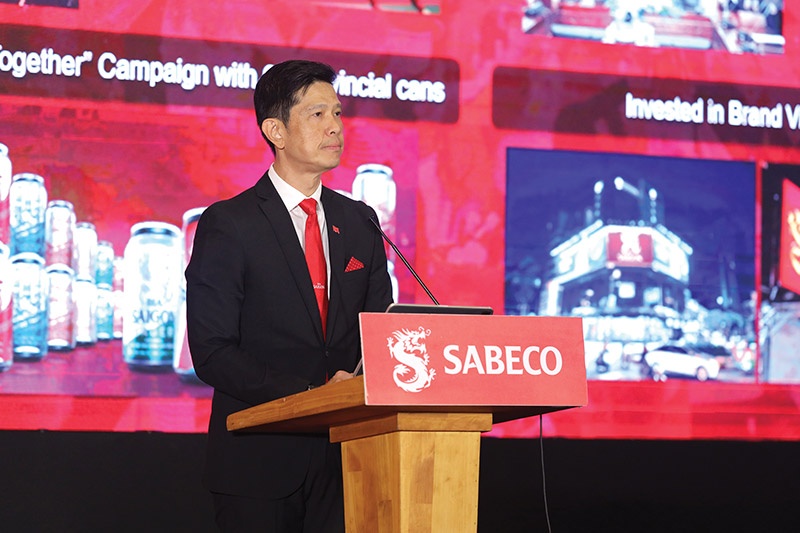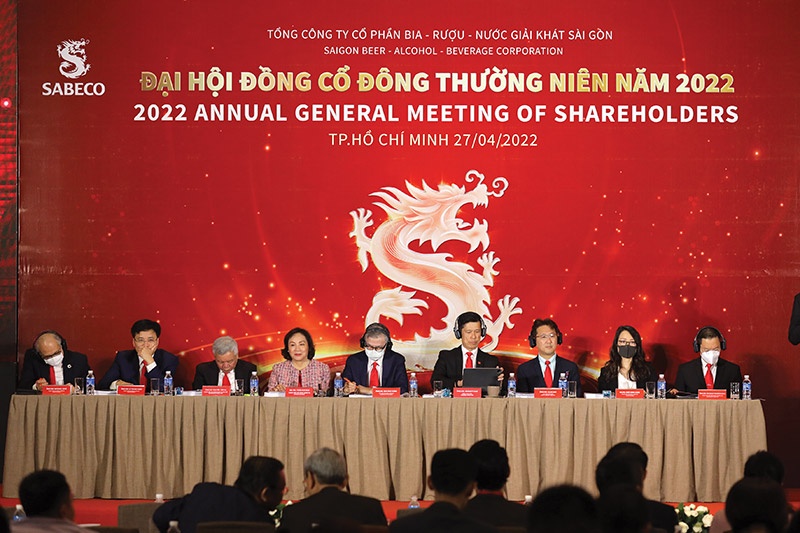SABECO displaying vigilance in new transformation phase
 |
| "SABECO, together with all our partners, will work hand-in-hand with the common goal of expanding our business with a core focus on topline growth and value creation." Bennett Neo General director SABECO |
Looking back at 2021 and poring over the outlook for the rest of this year, Koh Poh Tiong – chairman of the Board at SABECO – sent a positive message to shareholders, customers, and staff with the spirit of solidarity and perseverance.
“Despite the uncertainties, I have every confidence in the capabilities of the Vietnamese government and a strong belief that SABECO will emerge on the other side with a more effective and resilient business operation and achieve better business performance compared to 2021,” Tiong said at the company’s most recent annual general shareholders’ meeting.
Meanwhile, general director Neo Bennett added, “We have held up our business operation and brand performance despite a challenging 2021. We thrived to maintain the stability of our operation and focus on maximising both the domestic market as well as our export business opportunities. SABECO will soon find its pot of gold at the end of the rainbow.”
 |
| SABECO’s leaders have issued positive words when it comes to the company’s ambitions for the rest of the year and beyond |
Setting priorities
Initially launched in 2020, SABECO 4.0 is a strategic initiative to transform the business using digital technologies. This involves overhauling business processes and organisational structures, harnessing data, improving information flow in order to make better decisions, improving governance structures, and automating the business with digital technologies where possible.
The end goal SABECO wants to achieve is to optimise, standardise, and automate the way of working across entities nationwide in order to strengthen its market leadership in the Vietnamese beer market.
Neo also detailed how SABECO 4.0 could cut costs and increase profits. “It is about simplification, standardisation, and centralisation of all processes. In short, if you increase revenue and reduce costs, you would have higher profits. You could also control capital expenses better, and your depreciation would come down as well. Hence, SABECO 4.0 has affected all areas, from the revenue line to the bottom line.”
Under phase 2, the corporation will focus on the key pillars of sales, brand/marketing, production, supply chain, people, and “unlocking”, supported by SABECO 4.0 and governance initiatives.
Explaining the “unlocking” pillar, Neo said, “We have a lot of potential in terms of processes, structure, and assets that we have not optimised yet. If we could simplify processes, we would have better productivity, revenue, and cost reduction. Another example could be that SABECO can share services with its 44 companies, and there are a lot of common activities that can be centralised.”
SABECO has set a target revenue of VND34.79 trillion ($1.51 billion), and profit after tax at VND4.58 trillion ($199 million), in 2022, up 32 and 17 per cent on-year, respectively. It has also set more aggressive targets for further market share in 2022, although it is yet to reveal data.
In 2022, SABECO is also focusing on market expansion both domestically and internationally. In addition to this, it will continue to build a stronger product portfolio in line with the trend of consumption, while continuing to restructure its distribution and route-to-market ecosystem.
Earlier this year, top brand Bia Saigon was reborn with a new taste and packaging to reinforce the company’s long-term ambition to boost brand positioning and expand its market with creative and pioneering goods and services.
Expanding sustainability
Although the market looks positive, the beer sector is facing issues with rising packaging and materials costs. However, SABECO is pushing to address and overcome them.
The company has already carried out purchase programmes to buy in advance, especially for strategic materials like malt and aluminium cans. “So far, we have been quite fortunate that we were well covered for the year 2022, and are already looking at 2023 right now,” Neo said.
However, input costs are still increasing. At the company’s quarterly investor briefing, another oft-mentioned factor deemed equally as important as the cost is the availability of materials. Logistical challenges that are being affected by the current situation in Ukraine and the various pandemic restrictions are still unpredictable. “Even though our products have not gone through China, there were repercussions,” Neo added. “In short, if there were no raw materials, we could not produce beer. We have worked day and night to ensure availability at the optimal cost.”
Packaging costs also account for a substantial proportion of input costs at SABECO, which has been looking internally to improve efficiencies in areas of consumption and energy usage. Reductions have also been found in other fixed overheads in manufacturing. Alan Koo, chief financial officer of SABECO, explained, “Another angle to look at was how to improve our product mix or brand mix to improve profitability and mitigate all these input cost increases. The last option is to administer a price increase if and when the market permits. Hence, we were always looking at both internal and external factors to manage income costs.”
Together with business development, SABECO will expand its sustainability efforts through tripartite partnerships with the government, private sector, and social organisations. It continues to build upon its commitment to sustainable development, focusing on the four 4Cs of consumption, conservation, country, and culture. The corporation will also roll out initiatives with its sustainable development strategy in mind.
“SABECO, together with all our partners, will work hand-in-hand with the common goal of expanding our business with a core focus on topline growth and value creation,” Neo explained. “We will remain vigilant and focus on our business performance, as well as our ambition to thrive on bringing out the best in Vietnam and promoting our brands to the world.”
SABECO increased its post-tax profit by 25 per cent on-year to VND1.2 trillion ($52.27 million) in Q1 due to the reintroduction of tourism and various services. The largest brewer in Vietnam also saw revenues rise at the same rate to over VND7.3 trillion ($317.4 million), while also managing to lower sales and management costs by more than 10 per cent.
What the stars mean:
★ Poor ★ ★ Promising ★★★ Good ★★★★ Very good ★★★★★ Exceptional
Related Contents
Latest News
More News
- Tungsten surges to 12-year high as world enters a new 'black gold' race (December 18, 2025 | 17:27)
- Vietnam’s coffee exports set new record despite price pressures (December 18, 2025 | 17:13)
- Garment and textile sector seeks new growth after volatile year (December 18, 2025 | 17:01)
- VinSpeed and Siemens strengthen cooperation for high-speed rail development (December 18, 2025 | 16:53)
- High-tech adoption for TH true MILK (December 18, 2025 | 13:39)
- Takeda supports health resilience amid climate change challenges (December 18, 2025 | 12:39)
- Mondelez Kinh Do - a chapter of purpose-led leadership in Vietnam (December 18, 2025 | 09:44)
- VNPAY services receive the highest-level PCI DSS international security certificates for six consecutive years (December 17, 2025 | 23:47)
- PPL extends its reach into ASEAN (December 17, 2025 | 15:44)
- Over 600 BUV graduates meeting quality benchmarks across triple quality assurance levels (December 17, 2025 | 13:00)

 Tag:
Tag:




















 Mobile Version
Mobile Version